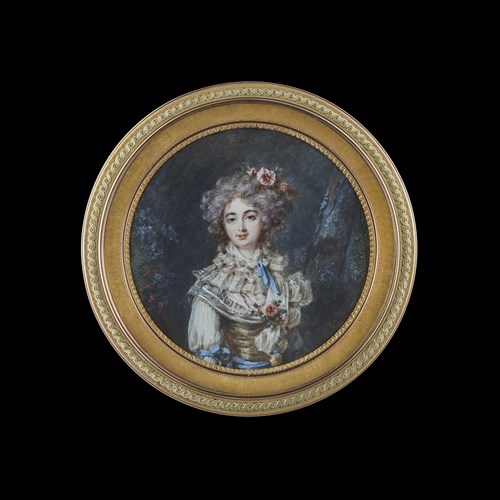Marketplace
Portrait miniature of a Young Gentleman, wearing armour with lawn collar, his hair worn long and curled, circa 1650-55
RICHARD GIBSON
Portrait miniature of a Young Gentleman, wearing armour with lawn collar, his hair worn long and curled, circa 1650-55
The Limner Company : Portrait Miniature
Date circa 1650-55
Medium Watercolour on vellum
Dimension 5 cm (2⁰/₁ inches)
Likely painted just after the end of the English Civil War, and in the recent memory of Charles I’s execution, this portrait by Richard Gibson shows a young man who likely fought in the conflict. Although his plain armour and simple lawn collar may indicate that this sitter was on the side of the Parliamentarians, it is not easy to discern the sitter’s allegiance from his clothing alone. As with many artists, Gibson remained politically neutral – possibly in order cast his net for patrons wider. He had strong links with the royal family, who by this date were either dead, on the run or in exile, having been a page to Charles I and later married by him, to his wife Anne Sheppard who had been in the service of Henrietta Maria. He likely spent most of the Civil War period at Wilton House, the home of the Earls of Pembroke, with whom he had enjoyed a long patronage.
Gibson had a long and fascinating life and a successful career as a miniaturist or limner. As a dwarf, who was 3 feet 10 inches in height, he was unique in breaking from the servitude of English court life to direct his own profession. What is clear is that he was a talent to nurture from an early age - his early training was under Francis Cleyn (c. 1582-1658) and from the late 1630s he entered the service of the Lord Chamberlain, Philip, 4th Earl of Pembroke. It was in Lord Pembroke’s household that Gibson met his future wife, Anne Sheppard (d. 1707), who was also a dwarf. Their marriage, in February 1641, was one of the last court festivities in London before the onset of the Civil War.
After his death in 1650, Lord Pembroke’s patronage was taken up by his grandson, the 2nd Earl of Carnarvon. Throughout this period and after the Restoration in 1660, Gibson’s work was much in demand. In 1672 he was made ‘picture maker’ to Charles II after the death of the previous incumbent, Samuel Cooper, moving to fashionable Covent Garden in London around this time. The following year, Gibson relinquished the post when he was appointed drawings master to the daughters of James, Duke of York. In 1677, he accompanied Princess Mary to the Hague at the time of her marriage to Prince William of Orange, remaining in the Netherlands for over ten years. He returned to London when Princess Mary and William of Orange acceded to the British throne 1688.
Gibson had a long and fascinating life and a successful career as a miniaturist or limner. As a dwarf, who was 3 feet 10 inches in height, he was unique in breaking from the servitude of English court life to direct his own profession. What is clear is that he was a talent to nurture from an early age - his early training was under Francis Cleyn (c. 1582-1658) and from the late 1630s he entered the service of the Lord Chamberlain, Philip, 4th Earl of Pembroke. It was in Lord Pembroke’s household that Gibson met his future wife, Anne Sheppard (d. 1707), who was also a dwarf. Their marriage, in February 1641, was one of the last court festivities in London before the onset of the Civil War.
After his death in 1650, Lord Pembroke’s patronage was taken up by his grandson, the 2nd Earl of Carnarvon. Throughout this period and after the Restoration in 1660, Gibson’s work was much in demand. In 1672 he was made ‘picture maker’ to Charles II after the death of the previous incumbent, Samuel Cooper, moving to fashionable Covent Garden in London around this time. The following year, Gibson relinquished the post when he was appointed drawings master to the daughters of James, Duke of York. In 1677, he accompanied Princess Mary to the Hague at the time of her marriage to Prince William of Orange, remaining in the Netherlands for over ten years. He returned to London when Princess Mary and William of Orange acceded to the British throne 1688.
Date: circa 1650-55
Medium: Watercolour on vellum
Dimension: 5 cm (2⁰/₁ inches)
Provenance: Private Collection, UK
More artworks from the Gallery




 Sheridan (1775-1817)_T638882698570737886.jpg?width=500&height=500&mode=pad&scale=both&qlt=90&format=jpg)
, wearing lawn collar, his hair long and curled_T638688390047901881.jpg?width=500&height=500&mode=pad&scale=both&qlt=90&format=jpg)
, wearing an orange d_T638882691460356649.JPG?width=500&height=500&mode=pad&scale=both&qlt=90&format=jpg)
-Portrait miniature of a Lady of the French royal family, possibly Anne of Austria (1601-1666), Queen of France_T638913686204170000.JPG?width=500&height=500&mode=pad&scale=both&qlt=90&format=jpg)
 of Standlynch (1619-70)_T638912317218987991.JPG?width=500&height=500&mode=pad&scale=both&qlt=90&format=jpg)
